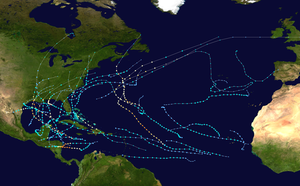| Timeline of the 2020 Atlantic hurricane season | |
|---|---|
 Season summary map | |
| Season boundaries | |
| First system formed | May 16, 2020 |
| Last system dissipated | November 18, 2020 |
| Strongest system | |
| Name | Iota |
| Maximum winds | 155 mph (250 km/h) |
| Lowest pressure | 917 mbar (hPa; 27.08 inHg) |
| Longest lasting system | |
| Name | Eta |
| Duration | 11.75[nb 1] days |
The 2020 Atlantic hurricane season was the most active Atlantic hurricane season on record in terms of number of named storms. Additionally, it was as an above-average season for tropical cyclones for the fifth consecutive year.[nb 2][2] The season officially began on June 1, 2020, and ended on November 30, 2020. These dates, adopted by convention, historically delimit the period each year when most Atlantic tropical systems form.[3] However, storm formation is possible at any time of the year, as was the case this season, when its first two named storms, Tropical Storm Arthur and Tropical Storm Bertha, formed on May 16 and May 27, respectively. The final storm, Hurricane Iota, dissipated on November 18.
Altogether, the season produced 31 tropical or subtropical cyclones, all but one of which became a named storm. Of the 30 named storms, 14 became hurricanes, and seven further intensified into major hurricanes.[nb 3] It was the second and final season to use the Greek letter storm naming system, the first being 2005.[5] Hurricane Laura produced catastrophic storm surge levels, heavy rainfall, and spawned over a dozen tornadoes after striking Louisiana on August 27 with winds of 150 mph (240 km/h). The storm was responsible for 81 deaths and it caused over US$19 billion in damage across the Greater Antilles and the Southern United States.[6] Causing significant late-season loss of life and widespread destruction were November hurricanes Eta and Iota, which made landfall in Central America as Category 4 storms just two weeks apart.[2] The storms left a toll of 184 deaths and 110 missing across the region, and thousands of families lost their homes and livelihoods.[7] In March 2021, the names Laura, Eta and Iota were retired from reuse in the North Atlantic by the World Meteorological Organization due to the extraordinary amount of damage and number of fatalities they caused.[8]
This timeline documents tropical cyclone formations, strengthening, weakening, landfalls, extratropical transitions, and dissipations during the season. It includes information that was not released throughout the season, meaning that data from post-storm reviews by the National Hurricane Center, such as a storm that was not initially warned upon, has been included.
By convention, meteorologists use one time zone when issuing forecasts and making observations: Coordinated Universal Time (UTC), and also use the 24-hour clock (where 00:00 = midnight UTC).[9] The National Hurricane Center uses both UTC and the time zone where the center of the tropical cyclone is currently located. The time zones utilized (east to west) are: Greenwich, Cape Verde, Atlantic, Eastern, and Central.[10] In this timeline, all information is listed by UTC first, with the respective regional time zone included in parentheses. Additionally, figures for maximum sustained winds and position estimates are rounded to the nearest 5 units (knots, miles, or kilometers), following National Hurricane Center practice. Direct wind observations are rounded to the nearest whole number. Atmospheric pressures are listed to the nearest millibar and nearest hundredth of an inch of mercury.
Cite error: There are <ref group=nb> tags on this page, but the references will not show without a {{reflist|group=nb}} template (see the help page).
- ^ "Background Information: North Atlantic Hurricane Season". College Park, Maryland: NOAA Climate Prediction Center. Retrieved August 6, 2020.
- ^ a b Doyle Rice (November 30, 2020). "Record-shattering 2020 Atlantic hurricane season officially comes to an end". USA Today. Retrieved April 30, 2021.
- ^ "Hurricane Season Information". Frequently Asked Questions About Hurricanes. Miami, Florida: NOAA Atlantic Oceanographic and Meteorological Laboratory. June 1, 2018. Retrieved June 29, 2020.
- ^ "Saffir-Simpson Hurricane Wind Scale". Miami, Florida: National Hurricane Center. Retrieved August 6, 2020.
- ^ "Record-breaking Atlantic hurricane season draws to an end". Silver Spring, Maryland: National Oceanic and Atmospheric Administration. November 24, 2020. Retrieved April 30, 2021.
- ^ Lucy Bergemann (May 29, 2021). "NHC Releases Hurricane Laura Report". WeatherNation. Retrieved June 18, 2021.
- ^ "Central America: Hurricanes Eta and Iota" (PDF). Humanitarian Situation Report No.7. Panama City, Panama: UNICEF Latin America and Caribbean Regional Office. January 2021. Retrieved June 18, 2021.
- ^ "WMO Hurricane Committee retires tropical cyclone names and ends the use of Greek alphabet". Geneva, Switzerland: World Meteorological Organization. March 17, 2021. Archived from the original on December 18, 2023. Retrieved April 29, 2021.
- ^ "Understanding the Date/Time Stamps". Miami, Florida: NOAA National Hurricane Center. Retrieved July 10, 2020.
- ^ "Update on National Hurricane Center Products and Services for 2020" (PDF). Miami, Florida: National Hurricane Center. April 20, 2020. Retrieved May 17, 2020.
